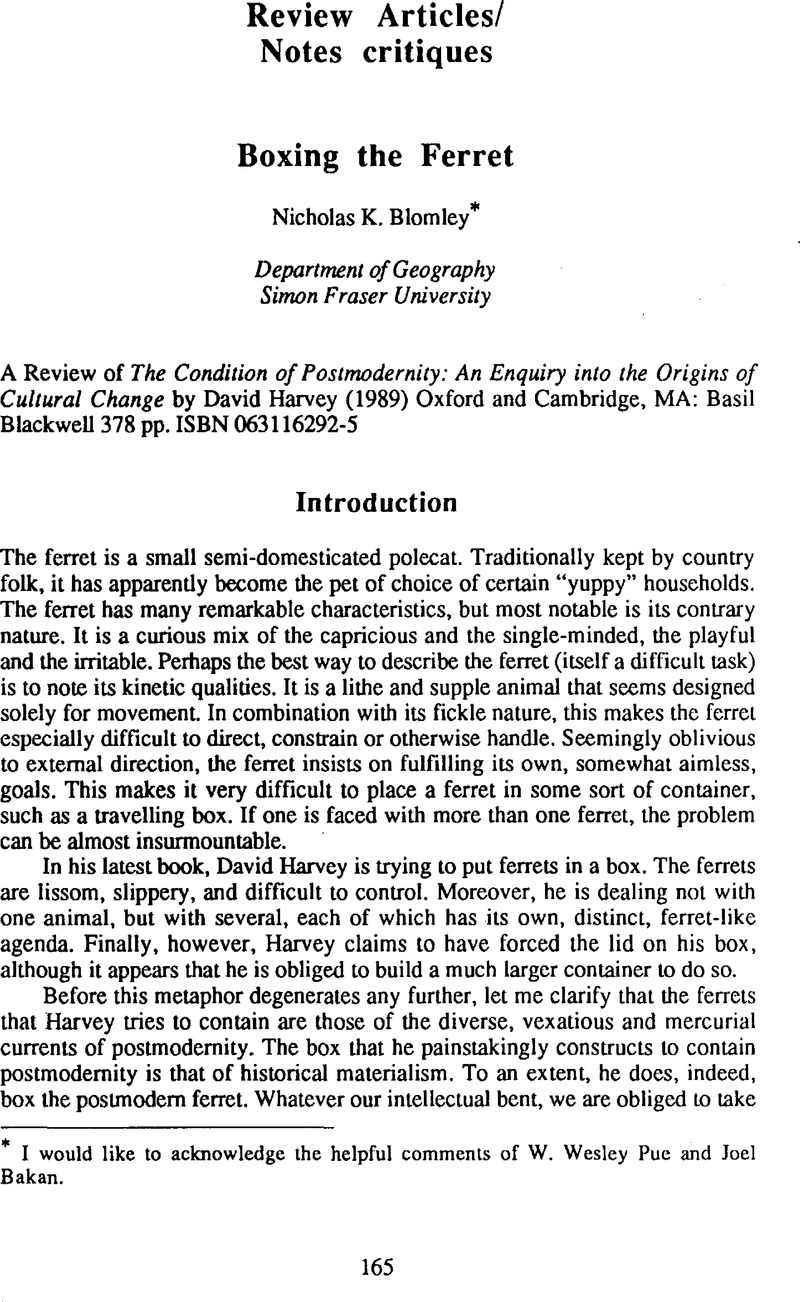No CrossRef data available.
Article contents
Boxing the Ferret
Published online by Cambridge University Press: 18 July 2014
Abstract

- Type
- Review Articles/Notes critiques
- Information
- Canadian Journal of Law and Society / La Revue Canadienne Droit et Société , Volume 6 , 1991 , pp. 165 - 179
- Copyright
- Copyright © Canadian Law and Society Association 1991
References
1. Marcuse, Herbert, One-Dimensional Man (Beacon Press: Boston, 1964), p. 190Google Scholar.
2. Compare, for example, the ‘ambivalent postmodernism’ of Hunt, Alan (eg ‘The big fear: law confronts postmodernism’ McGill Law Journal 1990, 35, 3, 507–540)Google Scholar with the more enthusiastic embrace of Hutchinson, Allan (e.g. Dwelling on the threshold: critical essays in modern legal thought (Carswell: Toronto, 1988))Google Scholar.
3. cf Jenson, Jane, “‘Different’ but not ‘exceptional’: Canada's permeable fordism,” Canadian Review of Sociology and Anthropology 26, 1 (1989), pp. 69–94CrossRefGoogle Scholar.
4. Drache, Daniel and Glasbeek, Harry, “The new fordism in Canada: Capital's offensive, labour's opportunity,” Osgoode Hall Law Journal 27, 3, (1989) pp. 517–560Google Scholar.
5. The radical use of history is evidenced by writers such as Thompso, Edward P, Whigs and Hunters: the origins of the Black Act (Allen Lane, London, 1975)Google Scholar or Hall, J., “Theft, law and society: the Carrier's case,” in Chambliss, W. J., Crime and the legal process (New York: McGraw Hill, 1969), pp 32–51Google Scholar. It is also evidenced by those authors concerned with ethnicity or gender, such as Kobayashi, Audrey, “Racism and the law in Canada: a geographical perspective,” Urban geography 11, 5 (1990) pp. 447–473CrossRefGoogle Scholar.
6. The standard account is given by Gordon, Robert W., “Critical legal histories,” Stanford law review 36, 57 (1984) pp. 57–125CrossRefGoogle Scholar.
7. Hutcheon, Linda, The Politics of Postmodernism (London: Routledge, 1989) pp. 57CrossRefGoogle Scholar.
8. For example, see de Sousa Santos, B., 1987, “Law: a map of misreading: Toward a postmodern conception of law,” Journal of Law and Society 14, 3, 279–302CrossRefGoogle Scholar, or Engel, David M., 1990, “Litigation across space and time: courts, conflict, and social change,” Law and Society Review 24, 2, 333–344CrossRefGoogle Scholar. I also sense that a nascent geographical imagination (albeit often confused) can be seen in the recent ‘communitarian’ debate (see, for example, the essays in Hutchinson, Allan C. and Green, Leslie J., eds., Law and the community: the end of individualism? (Toronto: Carswell, 1989)Google Scholar.
9. Holmes, Oliver Wendell, The Common Law (Cambridge, MA: Belknap Press, 1963, 1881), p. 1Google Scholar (my emphasis).
10. Soja, Edward W., Postmodern geographies: The reassertion of space in critical social theory (London: Verso, 1989)Google Scholar.
11. There is, however, a growing literature that explores many of these questions. The interested reader might begin with a recent special edition of the journal Urban Geography (Vol. 11, 5 and 6) which draws together the work of both geographers and legal scholars, all of whom are concerned with the law-space interface.
12. Foucault, Michel, “Of other spaces,” Diacritics, Spring (1986), p. 22–27Google Scholar.
13. Cf Bakan, Joel C. and Blomley, Nicholas K., “Privatizing the worker,” forthcoming in Environment and Planning, 1991Google Scholar.
14. Cf Blomley, Nicholas K., “The business of mobility,” forthcoming in Canadian Geographer, 1991Google Scholar.


